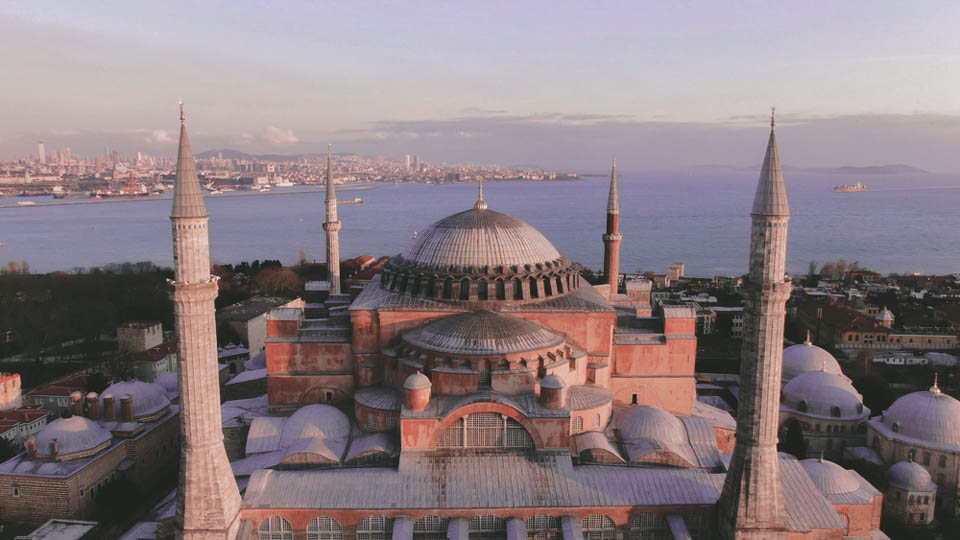A Brief History of Hagia Sophia

Hagia Sophia is a basilical planned cathedral built by Eastern Roman Emperor Justinianus in 532-537
Such a short time, huh? Exactly
Ottoman sultan Mehmet II. converted it into a mosque in 1453 right after conquest of Constantinople by Turks
Building’s name Sophia derives from Greek word sophos which means “wisdom” so full name Hagia Sophia means “holy wisdom” and it’s one of the three attributes of God in Orthodoxy.
Approximately 10.000 people worked for construction and obviously Justinian spent a fortune for it. Some materials such as columns, doors, stones were transferred from older temples and sanctuaries like Artemission in Ephesus, Heliopolis Sun Temple in Egypt, Baalbek Temple in Lebanon. How they could bring such big and heavy materials in such a short time makes people fascinated.
Because it was the center of Constantinople Patriarch, Hagia Sophia consisted of a large collection of “relics” such as Jesus’ cross, crystal pot with the blood of Jesus, etc.
After Hagia Sophia was converted to a mosque, mosaics describing faces remained untouched and mosaics without faces were never destroyed or harmed thanks to Ottoman sultan Mehmed II’s tolerance. They were all covered with plaster and all kept safe from natural or artificial destruction. When Mustafa Kemal Ataturk converted it into a museum, the restoration team cleaned the plaster thus the mosaics were brought to light again.
In brief all people visiting museum’s breathtaking mosaics in awe owe this to two fantastic people :
- Ottoman sultan Mehmed II :having so much tolerance as the first Muslim emperor of Constantinople
- Mustafa Kemal Ataturk : conversion of the mosque into a museum and gifting its Roman Christian legacy to all humanity
Hagia Sophia is actually the third one built in the same location so it’s also known as the third Hagia Sophia. First two churches were destroyed by frustrated rebellions.
It’s believed that the second Hagia Sophia hosted the second Ecumenical and first İstanbul Council. Unfortunately that church was burnt in Nika Riot in 532. Finds, portico ruins, columns, some of the capitals can be seen in the garden today. The second church used to be 2 metres below today’s ground.
After suppressing the riot Justinian ordered a new, greater church to be constructed. He employed two renowned architects of the time, Isidorus of Miletus and Anthemius of Tralles. Red porphyry from Egypt, green porphyry from Greece, white marble from Marmara, yellow stone from Syria and Black stone originally from Istanbul are colored stones used in veneers and columns.
Construction work ended in 537 and Justinian opened his church with a great ceremony. Since Hagia Sophia was bigger than the Holy Temple of Solomon, which was accepted as the largest building up to that time. Emperor Justinian started his speech with “Solomon, O Solomon, I beat you!”.
Some facts about Hagia Sophia:
- It’s the world’s oldest Cathedral.
- It was the world’s biggest cathedral for 1000 years up until 1520 Seville Cathedral
- It’s a combination of basilical and central planned domed basilica. It’s the 4th one today by its acreage.
- Quickest built cathedral ever. Only 5 years.
- It's around 15000 years old, still standing despite extreme earthquakes.
- No other basilica could have ever accomplished such a big area until the 6th century but Hagia Sophia did.
- A complex and sophisticated system applied in Hagia Sophia consisted of half domes, arches and vaults.
- Main dome supported by half domes covers such a big area that it’s perceived as a dome dominating the interior.
- System was completed by switching from half domes to smaller half domed exedras.
- This hierarchy in the dome system was never been seen in antique architecture before.
- They used mortar rather than brick for construction.
- Architect Fossetti brothers painted it red and yellow before.
- When Ottomans conquered Constantinople and converted H. Sophia into a mosque it was actually such a mess and about to fall. Sinan the Architect added retaining walls and in this case we can say Turks totally saved it from corruption.
- Ottomans never changed its name even when it was a mosque for almost 5 centuries.
- Sultans added 4 towers (minarets) around the main building; these massive blocks were also used as retaining walls to push the main structure from four sides.
- Emperor’s Lodge, marble minbar, mihrab, fountain, library, two gigantic marble jars, giant oil lamps, sermon, second preacher gathering balcony, round giant tables, and princes' tombs were added by the Ottomans.
- Ottoman sultans’ tombs are still in Hagia Sophia’s courtyard.
- It was converted into a mosque again in 2020. Today Hagia Sophia is still a mosque and free to visit.








0 comments